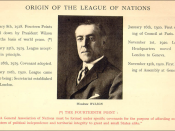When the League of Nations was set up, it has four main aims. They were: to encourage nations to disarm; to discourage aggression; to improve living and working conditions of people all round the World; and to encourage countries to cooperate. The League was successful in some areas, particularly in with its various commissions and mandates, but over all, it was unsuccessful in achieving its aims.
When it came to organisation, the League was quite unsuccessful. The USA, USSR and Germany all started off outside the League, unanimous decisions meant that motives were hardly ever passed, the court was not able to enforce any of its decisions as it had no army, and the entire League was flawed with its naïve assumption that all countries would want to disarm. However, the League's organisation did involve a lot of countries, had strong mandates from the Versailles Settlement, had a strong secretariat in Geneva, and had a clear set of rules.
The League was not very good at keeping the peace either. It did split Upper Silesia successfully between the Germans and the Poles, settle the dispute of the Aaland Islands, prevent war between Greece and Bulgaria, and managed to hold off another major war (but only until 1939). On the other hand, the League did nothing to stop the Poles taking Vilna, allowed Mussolini to undermine the Corfu Settlement, and was unable to solved influential powers' problems, as they had veto votes.
The League's aim to encourage disarmament failed completely! This was partly due to the naïve assumption that all the countries in the League wanted to disarm in the first place. However, at the same time, but outside the League, most countries did reduce their arms.
The League's greatest achievement was its ability to improve living and working...


